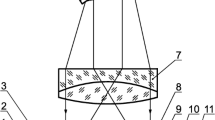Abstract
The principle of using gravimetry to measure the moisture content of a sample or a specimen is to determine the weight by a balance before and after drying.
Access provided by CONRICYT-eBooks. Download chapter PDF
Similar content being viewed by others
The principle of using gravimetry to measure the moisture content of a sample or a specimen is to determine the weight by a balance before and after drying.
where \(m_{\text{wet}} \;{\text{equals}}\;m_{\text{moisture}} + m_{\text{dry}}\).

From these two weights the moisture ratio can be presented as by dry weight
or by wet weight
In most cases these moisture ratios are given as per cent by dry or wet weight.
The dry weight depends of course on the drying procedure being used. This is described in Chap. 3.
1 Errors and Uncertainties
The main errors when using gravimetry to determine the moisture ratio of a sample are five, in principle:
-
drying of the sample during sampling and handling, before the wet weight is determined
-
loss of material from the sample during handling
-
wrong temperature or vapour content in the drying chamber
-
incomplete drying
-
lack of representativity of a sample of a heterogeneous material.
The moisture loss before the wet weigh determination is mainly connected to the procedure for sampling. This is further described in Chap. 22.
Errors connected to an incomplete drying are possible mostly when drying is carried out directly on-site, as in the case of portable thermo-balances. Here the weight measurement is performed very frequently (intervals of some minutes) and complete drying is not necessarily achieved when measurement stops; moreover weight measurement might be affected by wind, vibrations, etc.
The error connected to lack of representativity can be reduced by taking a larger sample, whose size must be determined on the basis of the nature of the material. Another alternative is to determine the degree of capillary saturation DCS, see Sect. 5.2 and Chap. 27.
2 Uncertainty Due to Sample Inhomogeneity
If a composite material consists of a mix of a porous part that can contain moisture and a non-porous part that has no moisture content, the determination of the moisture ratio of such a material depends on the representativity of the sample taken. With small samples from a material with large non-porous parts the representativity might be extremely bad. An obvious example is a small sample from a concrete with large aggregate particles.
The error E of the representativity can be expressed by
where mdry is the dry weight of a perfectly representative sample and Δmdry is the weight of the “additional” amount of non-porous parts making the sample non-representative.
The moisture ratio u of such a sample would be
which is equal to
where u0 is the moisture ratio of a perfectly representative sample. The error in the moisture ratio is a factor of 1/(1 + E).
The error is of course smaller the larger sample (larger mdry) that is taken. To overcome the drawback when it is essential to take small samples from a heterogeneous material the degree of capillary saturation can be determined, see Chap. 27.
Author information
Authors and Affiliations
Corresponding author
Editor information
Editors and Affiliations
Rights and permissions
Copyright information
© 2018 RILEM
About this chapter
Cite this chapter
Nilsson, LO. (2018). Gravimetry. In: Nilsson, LO. (eds) Methods of Measuring Moisture in Building Materials and Structures. RILEM State-of-the-Art Reports, vol 26. Springer, Cham. https://doi.org/10.1007/978-3-319-74231-1_5
Download citation
DOI: https://doi.org/10.1007/978-3-319-74231-1_5
Published:
Publisher Name: Springer, Cham
Print ISBN: 978-3-319-74230-4
Online ISBN: 978-3-319-74231-1
eBook Packages: EngineeringEngineering (R0)




